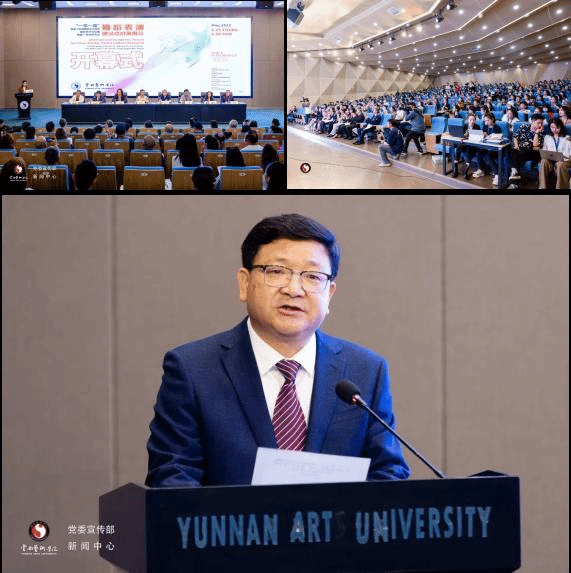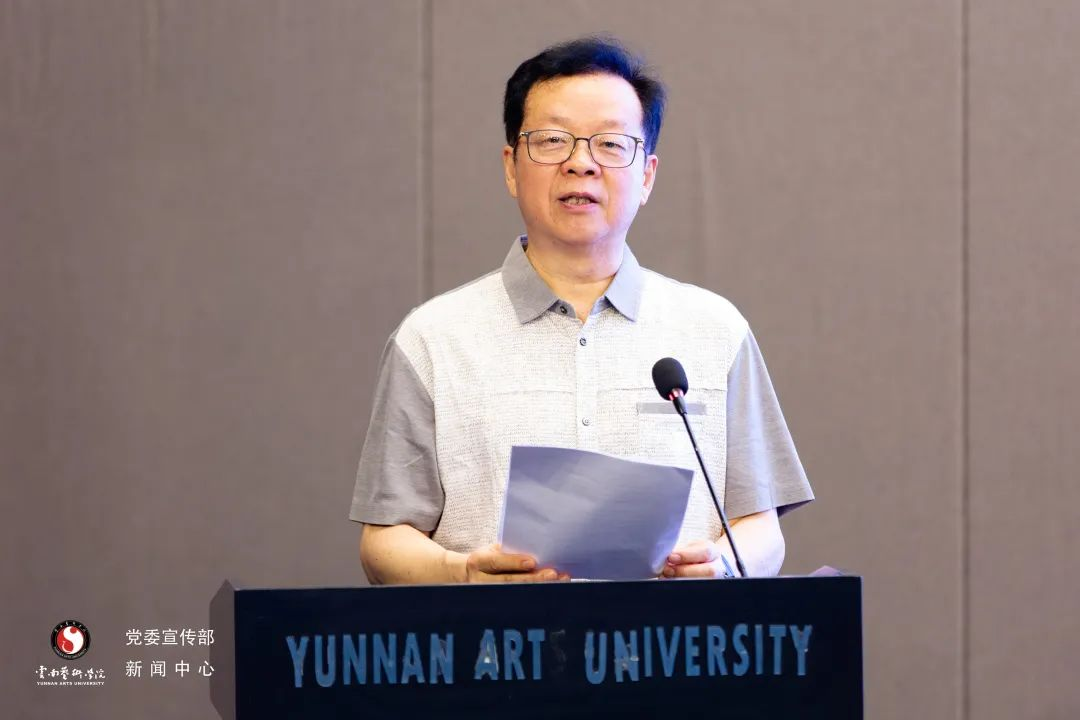On May 26, the international academic forum on regional dance culture research under the Belt and Road Initiative and achievement exhibition of "Dance Performance", one of the first batch of national first-class undergraduate majors, was hosted by YNAU and organized by the Dancing School. The event was opened at YNAU's Chenggong Campus.

Ouyang Junhu, deputy secretary of the CPC Committee of and president of YNAU, first extended a warm welcome and gratitude to all the invited experts and scholars who came to participate in the forum. In his address, Ouyang Junhu emphasized that YNAU is dedicated to nurturing talents for the Communist Party of China and the nation. Aligned with General Secretary Xi Jinping's "three-pronged approach" to Yunnan's development, the university is working hard to showcase Chinese characteristics, leverage comprehensive advantages,and promote high-quality development in higher arts education and artistic creation in the new era. The Dancing School focuses on developing its unique characteristics, which are deeply rooted in local culture and ethnic traditions. With an inclusive and innovative approach, the School explores Yunnan's ethnic and folk traditional dance resources, while continuously deepening education and teaching reforms. The School is taking proactive steps to establish an education system for Yunnan's ethnic dances. He hopes that this event will serve as an opportunity for exchanging ideas, mutual learning, and exploring contemporary inheritance and innovation of regional traditional dance. This will contribute to the high-quality

development of the dance discipline and the in-depth development of the university.
Feng Shuangbai, Chairman of the Dancers Association of China, delivered a speech. He noted that in the history of contemporary dance development in China, the creation of Yunnan's ethnic dance has been a remarkable phenomenon that has attracted widespread attention. The dance works are imbued with humanistic, color, spatial, and imagery beauty, showcasing a unique narrative style of dance language. Examples of these works include "Zhaoshutun and Nanmunuona", "Ashima", "Dynamic Yunnan", and "Spirit of Peacock". These outstanding dance pieces not only portray the rich and colorful dancing styles of the various ethnic groups in Yunnan, but also exhibit the shared beauty in diversity of Yunnan's ethnic dances. He spoke highly of YNAU's educational philosophy, which involves preserving traditions, studying folk art, embracing both Chinese and foreign cultures, and serving society. He expressed his hope that YNAU would continue to flourish in Yunnan's fertile cultural landscape, using new ideas, perspectives, and methods to expand its presence on the global stage. He also expressed his desire for YNAU to continue creating exceptional dance works that inspire cultural innovation and creativity, with a forward-looking vision that encompasses modernization, internationalization, and beyond. By doing so, ethnic dances can connect with the world and share the beauty of dance art.
Jiang Dong, the former Deputy Director of the Dance Research Institute at the Chinese National Academy of Arts, noted that YNAU has a distinct regional advantage that can be leveraged to create a high-level platform for exchanges with South and Southeast Asia. The international academic forum provides an excellent opportunity for engaging with the global community. From the perspective of building first-class disciplines at the national level, Yunnan's ethnic dance education has made remarkable progress. As a region with a rich diversity of ethnic groups, Yunnan has created many outstanding works of ethnic art and has made significant progress in dance education, creation, performance, and theory. Given this context, the convening of the international forum by YNAU is a
natural and logical step forward.

The event encompasses three forums: the International Forum, the Education Forum, and the Graduate Forum, which delve into ten academic topics, including research on dance culture and dance education, two of the most actively evolving areas in the field of dance studies. Nearly 150 dance artists and experts from various fields who are interested in dance art, including 62 institutions from 10 countries and regions, including China,came together to explore the present and future of regional dance culture and dance education in the new era. As part of the three-year construction period for the national first-class undergraduate program in "Dance Performance", an exhibition of the national first-class courses "Representative Folk Dances of Yunnan National Minorities" and "Rehearsal of Dance Dramas" will be held on the 26 and 27 at the Experimental Theater located in YNAU's Mayuan Campus.
Scan the QR code to access the live broadcast.

A group photo of the attendees at the opening ceremony

The opening ceremony was attended by a number of renowned experts from China and abroad, including Feng Shuangbai, Chairman of the Dancers Association of China and Vice Director of the China Literature and Art Foundation, Yu Ping, former Director of the Department of Arts and Director of the Department of Culture and Technology of Ministry of Culture and Tourism, Honorary Dean of the Dance Academy at Nanjing University of the Arts, Ma Shengde, former Deputy Director and First-Class Inspector of the Department of Intangible Cultural Heritage at the Ministry of Culture and Tourism, Xu Rui, President of the Beijing Dance Academy, Deng Youling, Vice President of the Beijing Dance Academy, Ou Jianping, Honorary Director of the Dance Research Institute at the Chinese National Academy of Arts, Jiang Dong, former Deputy Director of the Dance Research Institute at the Chinese National Academy of Arts, Ouyang Junhu, deputy secretary of the CPC Committee of and president of YNAU, members of the university's Academic Committee, leaders of functional departments and secondary colleges, and representatives of faculty members and students. Liu Li, Vice Dean of the Dancing School at YNAU, presided over the ceremony.
YNAU will leverage this event to deepen its research on regional dance culture and the teaching system of ethnic dance, and promote the development of a more inclusive, open, and distinctive discipline of ethnic dance.